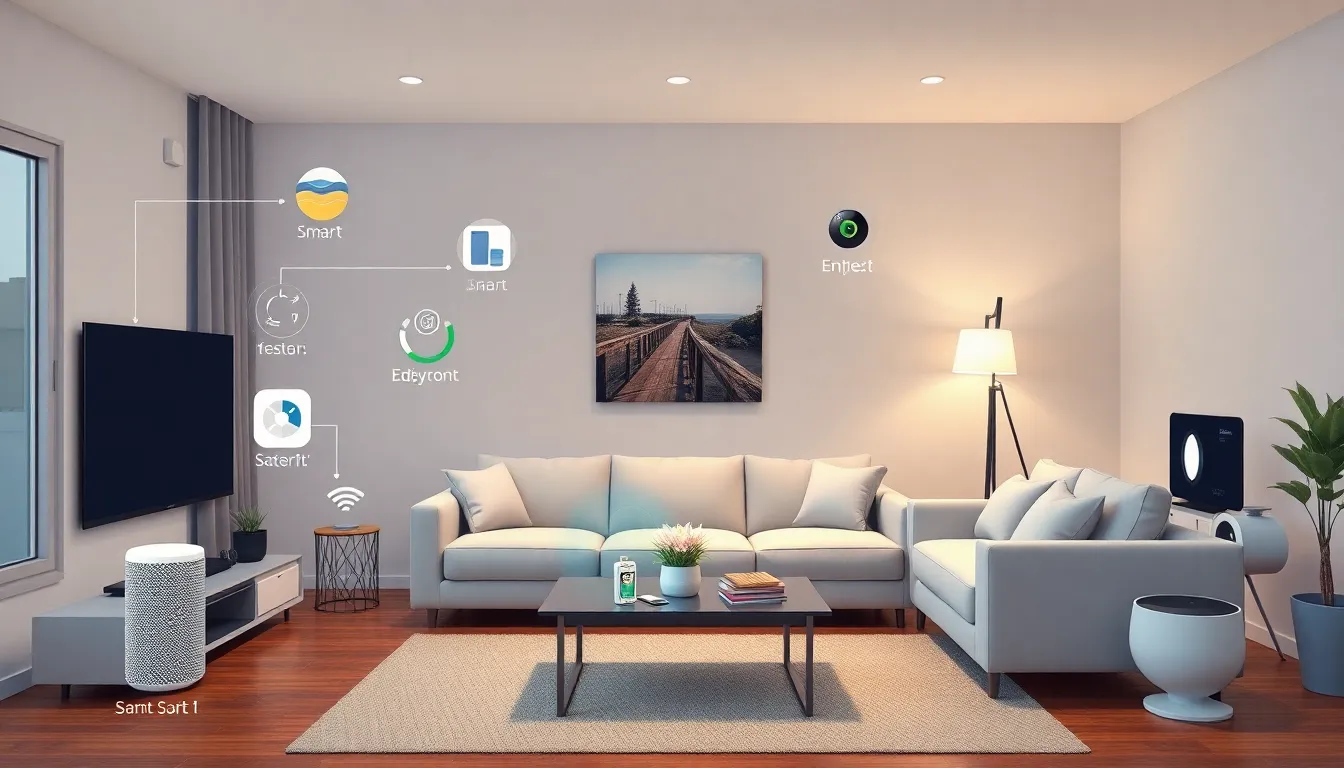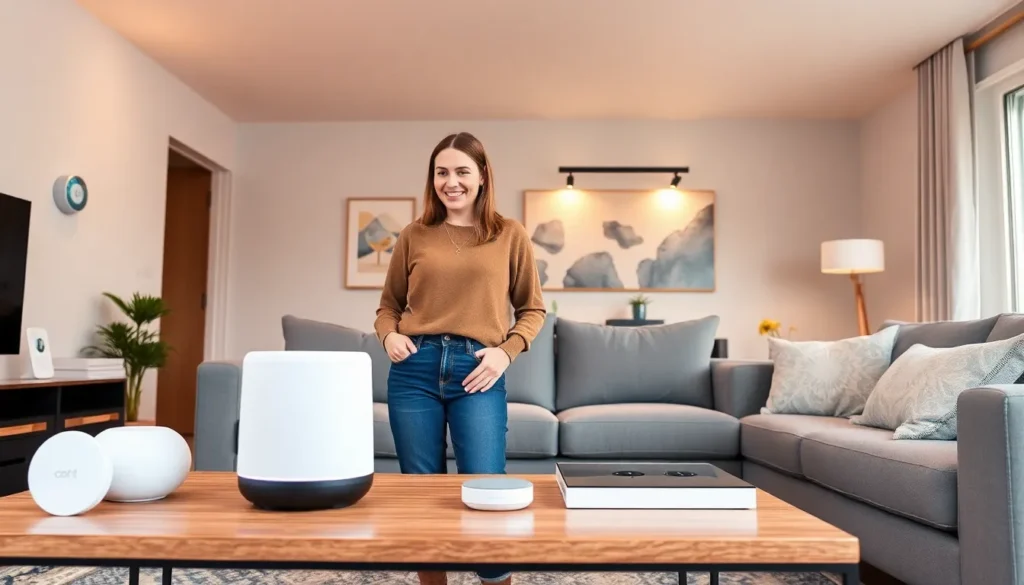Imagine waking up to a home that knows you better than your best friend. Smart living technology is transforming everyday spaces into intelligent sanctuaries that cater to personal needs and whims. It’s like having a personal assistant who never sleeps, always ready to adjust the thermostat or brew that perfect cup of coffee.
Overview Of Smart Living Technology
Smart living technology encompasses various devices and systems that enhance everyday life. Innovations in this field enable homes to adapt to users’ needs, providing convenience and comfort. These technologies include smart thermostats, lighting systems, security cameras, and voice-activated assistants.
Smart thermostats learn user preferences, adjusting temperatures automatically for optimal comfort and energy savings. Smart lighting systems allow users to customize brightness and color, creating suitable atmospheres for different activities. Many security cameras offer real-time monitoring and alerts, ensuring a safer living environment.
Voice-activated assistants streamline daily tasks. Users can control smart devices, play music, or access information simply by speaking. This hands-free operation adds to the convenience, making daily routines more efficient.
Integrating these technologies creates a cohesive, intelligent ecosystem within a home. The result is enhanced connectivity and communication among devices, allowing them to work seamlessly together. Data from smart living technology informs users of energy consumption patterns, promoting more sustainable living practices.
As technology evolves, smart living systems become increasingly sophisticated. The adoption of artificial intelligence in these devices facilitates deeper learning and personalization, customizing experiences based on individual behaviors. Users gain insights into their habits, enhancing overall life quality and well-being.
Industry experts project significant growth in the smart living market over the coming years. Increased consumer demand for convenience and efficiency drives this trend. Smart living technology not only simplifies tasks but also transforms how individuals interact with their living spaces.
Benefits Of Smart Living Technology

Smart living technology enhances everyday experiences, making life easier and more efficient. This technology provides numerous advantages that cater to user preferences and lifestyle.
Enhanced Convenience
Smart living technology strengthens convenience through automation and voice control. Users can adjust lighting, temperature, and security settings with simple commands or predetermined schedules. For example, smart assistants respond to voice prompts, allowing access to information or control of devices without using hands. Increased connectivity among devices also streamlines daily tasks, allowing appliances to communicate and coordinate actions. This interconnectedness eliminates the need for manual adjustments, bringing about a seamless living experience that adapts to individual routines.
Improved Energy Efficiency
Smart living technology significantly boosts energy efficiency in homes. Intelligent devices, like smart thermostats, learn user habits and optimize energy consumption accordingly. Monitoring energy usage in real time helps identify inefficiencies, providing homeowners with insights to reduce waste. By automating lighting and heating to align with presence or preference, these systems minimize energy costs. Additionally, energy-efficient appliances communicate with smart hubs to operate during off-peak hours, further lowering utility bills. This proactive approach promotes sustainability while saving consumers money on energy.
Popular Smart Living Devices
Smart living technology encompasses various innovative devices that enhance everyday experiences. Understanding these devices can significantly improve home functionality and comfort.
Smart Home Assistants
Smart home assistants serve as central hubs for managing connected devices within homes. They provide voice-activated control, allowing users to adjust settings effortlessly. Examples include Amazon Echo and Google Home, which respond to voice commands, playing music, setting reminders, and answering questions. Convenience comes from integration with other smart devices, enabling seamless operation of thermostats, lights, and security systems. Many assistants also learn user preferences over time, personalizing interactions and enhancing user experience.
Smart Security Systems
Smart security systems enhance home safety through advanced technology. Cameras equipped with real-time monitoring capabilities provide alerts for unusual activity, ensuring peace of mind. Systems like Ring and Arlo enable remote viewing via smartphones, giving users control while away from home. Additionally, smart locks offer keyless entry, allowing customized access for family members or guests. Real-time alerts and remote operation contribute to increased safety and convenience for homeowners, making these systems essential in modern living.
Integration With IoT
Integration with the Internet of Things (IoT) significantly enhances smart living technology. Smart devices communicate with one another, creating an interconnected ecosystem that optimizes user experience. Sensors embedded in appliances monitor performance and adjust settings automatically based on real-time data.
Smart thermostats, for example, leverage IoT to learn and adapt to user preferences. Through connectivity, these devices adjust temperatures during peak usage times, promoting energy efficiency. Lighting systems also utilize IoT, allowing users to control illumination remotely or through voice commands.
Security systems exemplify IoT integration by providing real-time alerts and remote monitoring features. Homeowners receive instant notifications about any suspicious activity, enhancing overall safety. Through mobile apps, users can access security feeds from anywhere, boosting peace of mind.
Smart home assistants serve as the central hub of this IoT ecosystem. They coordinate communication between devices, simplifying tasks and enabling smoother interactions. Voice-activated commands facilitate effortless management of various systems within the home.
User experience improves as smart living technology continues to evolve alongside IoT advancements. Artificial intelligence within these systems further personalizes recommendations and automates repetitive actions. As a result, individuals gain valuable insights into their habits, leading to improved lifestyle choices.
Industry reports indicate that the smart home market is expanding rapidly, driven by consumer demand for convenience and automation. This growth will accelerate as more homes adopt IoT-enabled solutions. Optimizing daily routines becomes more attainable as better integration occurs among smart living devices.
Future Trends In Smart Living Technology
Emerging advancements drive the future of smart living technology. Artificial intelligence plays a crucial role, enhancing device learning capabilities. Smart homes will become increasingly intuitive, adapting seamlessly to individual routines. Enhanced interoperability among devices leads to a unified smart ecosystem, offering effortless control across multiple platforms.
Sustainability remains a priority, encouraging the development of energy-efficient solutions. Homeowners will benefit from smart meters and appliances that optimize energy consumption in real time. These innovations not only reduce costs but also minimize their carbon footprint.
Resilient security features gain prominence, with biometric systems becoming more prevalent. Smart locks and cameras utilize facial recognition and motion detection, providing higher security levels for homeowners. Remote access capabilities empower users to monitor their properties from anywhere in the world.
Health monitoring integrations will transform smart living spaces. Smart appliances equipped with health tracking features will allow users to manage their well-being proactively. Wearable devices will communicate with home systems, creating comfortable environments that adapt to users’ health needs.
Voice control continues to evolve, with natural language processing improving user interaction. Seamless voice commands will become the norm, enabling users to operate devices intuitively. As technology advances, chatbots and virtual assistants will offer personalized support, anticipating user needs before they arise.
The integration of augmented reality and virtual reality into smart living experiences creates exciting possibilities. Users will visualize home configurations and customize designs in real time. Such capabilities enhance decision-making processes, offering a deeper connection to living spaces.
The future of smart living technology reflects a commitment to convenience, efficiency, and user-centric solutions, making everyday tasks simpler and more enjoyable.
Smart living technology is revolutionizing the way individuals experience their homes. By seamlessly integrating devices and systems, it creates environments that adapt to personal preferences and enhance daily life. This shift not only boosts convenience but also promotes energy efficiency and sustainability.
As advancements continue to unfold, the potential for smarter homes grows exponentially. The incorporation of artificial intelligence and IoT is paving the way for even more intuitive interactions. Homeowners can look forward to a future where their living spaces are not just functional but also tailored to their unique lifestyles.
Embracing smart living technology means stepping into a world of enhanced connectivity and personalized comfort. It’s an exciting journey that promises to redefine modern living for years to come.





